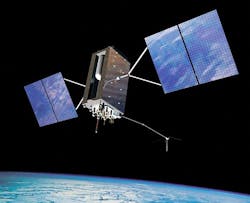Air Force taps Lockheed Martin to build two more advanced GPS III navigation satellites
Officials of the U.S. Air Force Space and Missile Systems Center at Los Angeles Air Force Base, Calif., are asking Lockheed Martin to build GPS Block III space vehicles 9 and 10. The company is under contract to build the first eight GPS III satellites, as well as the GPS III non-flight satellite testbed (GNST).
GPS-III satellites, which will replace aging on-orbit GPS satellites, will improve satellite navigation accuracy improve the GPS satellite constellation's ability to resist attempts to jam their signals to degrade or disable the system's capability. The existing GPS satellite constellation has been fully operational since 1995.
The GPS-III satellites also will extend each satellite's design life and add a new civil signal that is interoperable with international global navigation satellite systems. Air Force leaders plan to buy as many as 32 GPS III satellites, the first of which is scheduled for launch next year.
The GPS III program is part of a U.S. positioning, timing & navigation upgrade. The new GPS constellation will have 500 times the transmission power of the existing GPS system, and will have faster clock update rates.
Related: Air Force accelerates program to provide M-Code GPS receivers to warfighters worldwide
The enhanced reliability and anti-jam features of the GPS III satellites is expected to benefit U.S. and allied military forces, which increasingly rely on satellite-guided munitions, as well as civilian agencies and private business. U.S. and European aviation authorities have big plans to base future commercial aircraft navigation and guidance on signals from the GPS and other satellite-based positioning systems.
Air Force officials plan to buy as many as 12 GPS IIIA satellites. Subsequent versions of more-advanced GPS III satellites are envisioned to have cross-linking capabilities and spot beams to enable operators to boost the power of satellite signals so that the spacecraft can provide reliable service even in difficult or degraded conditions.
The GPS III team is led by the Global Positioning Systems Directorate at the Air Force Space and Missile Systems Center. Lockheed Martin is the GPS III prime contractor with teammates Harris Corp. (formerly Exelis), General Dynamics, Infinity Systems Engineering, Honeywell, ATK, and other subcontractors.
Air Force Space Command's 2nd Space Operations Squadron (2SOPS), based at Schriever Air Force Base, Colo., manages and operates the GPS constellation for civil and military users.
On this contract Lockheed Martin will do the work on GPS III satellites 9 and 10 in Littleton, Colo., and should be finished by August 2022. For more information contact Lockheed Martin Space Systems online at www.lockheedmartin.com/us/ssc.html, or the Air Force GPS Directorate at www.losangeles.af.mil.
Learn more: search the Aerospace & Defense Buyer's Guide for companies, new products, press releases, and videos
